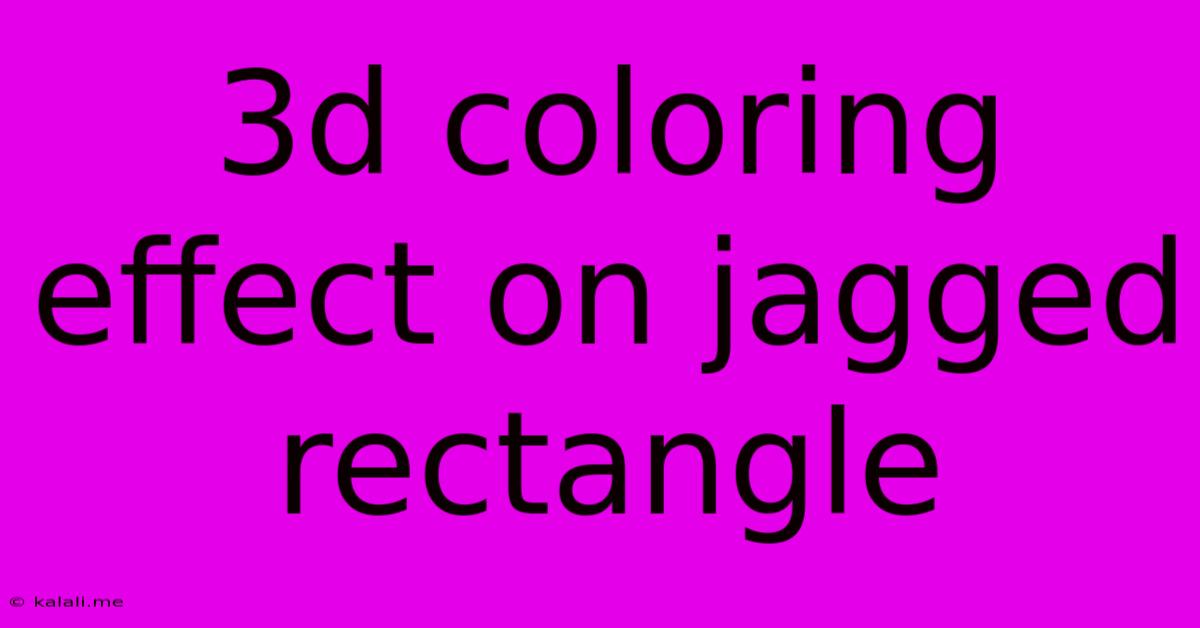3d Coloring Effect On Jagged Rectangle
Kalali
Jun 10, 2025 · 3 min read

Table of Contents
Achieving a 3D Coloring Effect on a Jagged Rectangle
Creating a convincing 3D effect on a simple shape like a rectangle, especially a jagged one, can significantly enhance the visual appeal of your designs. This article will guide you through the process of achieving a realistic 3D coloring effect on a jagged rectangle, leveraging shading and highlighting techniques to add depth and dimension. We'll explore both digital and traditional methods, providing you with a versatile understanding of this visual effect.
Understanding the Principles of 3D Representation
Before diving into the techniques, it's crucial to grasp the fundamental principles of 3D representation. The key lies in manipulating light and shadow to simulate volume and depth. This involves:
- Light Source: Identifying a primary light source is vital. This determines where highlights and shadows will fall. Consider the direction and intensity of the light.
- Highlights: These are the brightest areas on the shape, reflecting the light source directly. They usually appear on the parts of the shape facing the light.
- Shadows: These are the darker areas, representing the parts of the shape obscured from the light. Consider cast shadows (shadows projected onto other surfaces) as well as form shadows (shadows within the shape itself).
- Midtones: These are the areas between highlights and shadows, providing a smooth transition between light and dark.
Digital Methods: Utilizing Software for 3D Coloring Effects
Digital platforms offer precise control over color and shading. Software like Adobe Photoshop, Illustrator, or GIMP allow for intricate manipulation of gradients and layers to create a convincing 3D effect.
Step-by-Step Guide (Digital):
- Shape Creation: Create your jagged rectangle using your chosen software. Use the pen tool or a similar tool for precise control over the shape's edges.
- Base Color: Apply a base color to the rectangle. This will be the foundation for your 3D effect.
- Highlighting: Create a new layer and using a lighter shade of your base color, paint highlights along the edges facing your chosen light source. Use a soft brush for a smooth transition. Adjust the opacity to control the intensity of the highlight.
- Shading: On a new layer, use a darker shade of your base color to create shadows on the opposite edges. Again, use a soft brush for a smooth blend. Adjust opacity as needed.
- Ambient Occlusion (Optional): In areas where the shape's edges meet or create inward-facing angles, add slightly darker shading to simulate ambient occlusion—the subtle darkening in recessed areas.
- Layer Blending Modes: Experiment with layer blending modes (like Overlay, Multiply, or Soft Light) to refine the interaction between the highlight, shadow, and base layers.
- Refinement: Carefully refine the highlights and shadows, adjusting their intensity and placement until the 3D effect is convincing.
Traditional Methods: Achieving 3D Effects with Hand-Drawn Techniques
Traditional methods rely on skillful application of color and shading techniques using pencils, paints, or markers.
Step-by-Step Guide (Traditional):
- Sketching: Sketch your jagged rectangle lightly on your chosen surface.
- Base Color: Apply your base color, ensuring even coverage.
- Shading & Highlighting: Using a pencil or a darker shade of your base color, carefully shade the areas furthest from your light source. Use a lighter shade or white to highlight the areas closest to the light. Blend the transitions smoothly using a blending stump or your finger.
- Layering (Optional): If using paints, applying multiple layers of color allows for greater depth and control over shading. Start with lighter layers and gradually build up darker tones.
- Refinement: Continue refining your shading and highlighting until the 3D effect is satisfactory.
Conclusion:
Whether you prefer digital or traditional methods, achieving a convincing 3D coloring effect on a jagged rectangle relies on a solid understanding of light and shadow principles. By meticulously applying highlights and shadows, and blending them smoothly, you can transform a simple shape into a visually compelling element in your artwork or design. Remember to experiment and refine your technique to achieve your desired level of realism.
Latest Posts
Latest Posts
-
Can Brown Sugar Be Substituted For White Sugar
Jun 11, 2025
-
Is Float The Same As Varchar
Jun 11, 2025
-
How To Repair A Crack In A Fiberglass Bathtub
Jun 11, 2025
-
How To Clean A Mortar And Pestle
Jun 11, 2025
-
Do Capital Letters Matter In An Email Address
Jun 11, 2025
Related Post
Thank you for visiting our website which covers about 3d Coloring Effect On Jagged Rectangle . We hope the information provided has been useful to you. Feel free to contact us if you have any questions or need further assistance. See you next time and don't miss to bookmark.